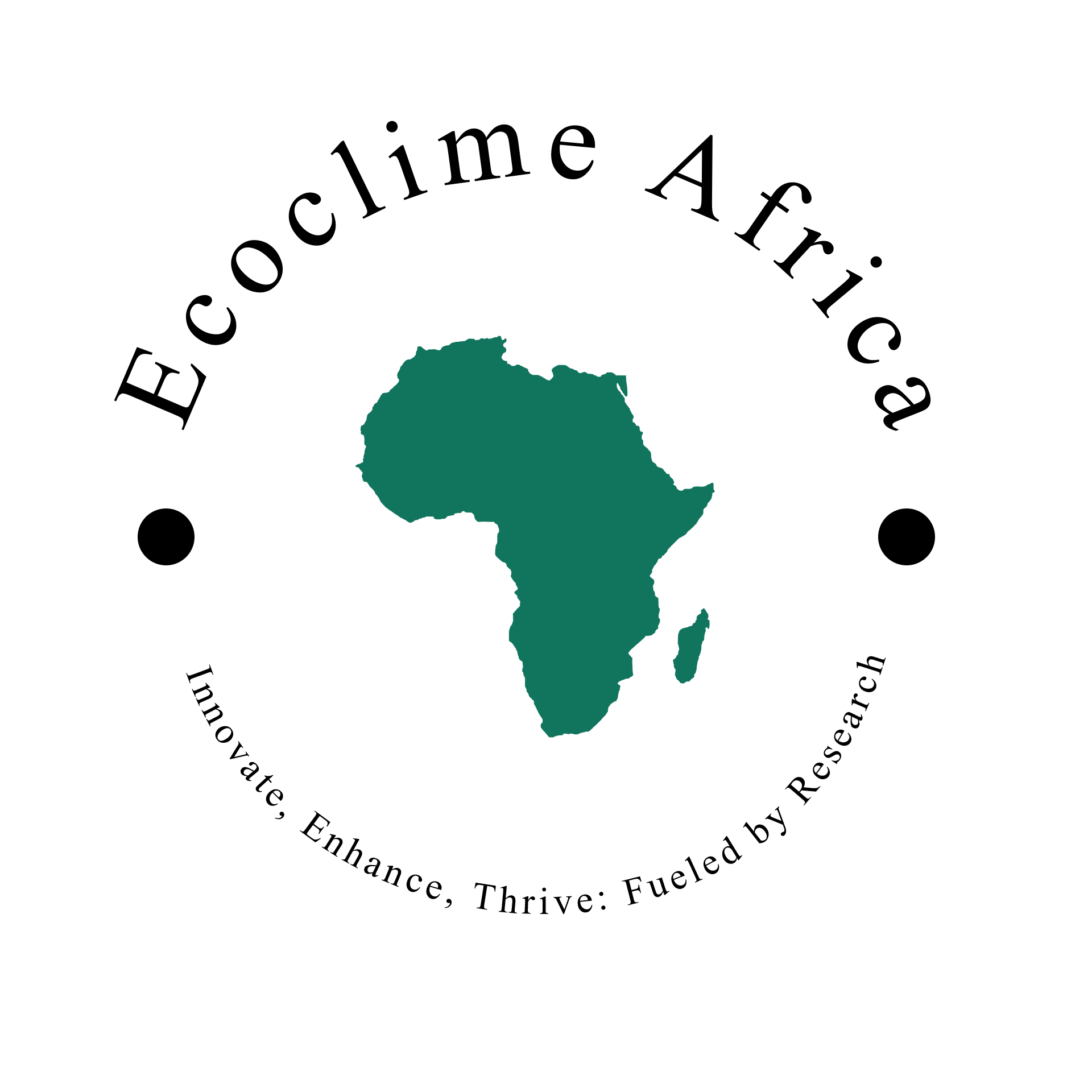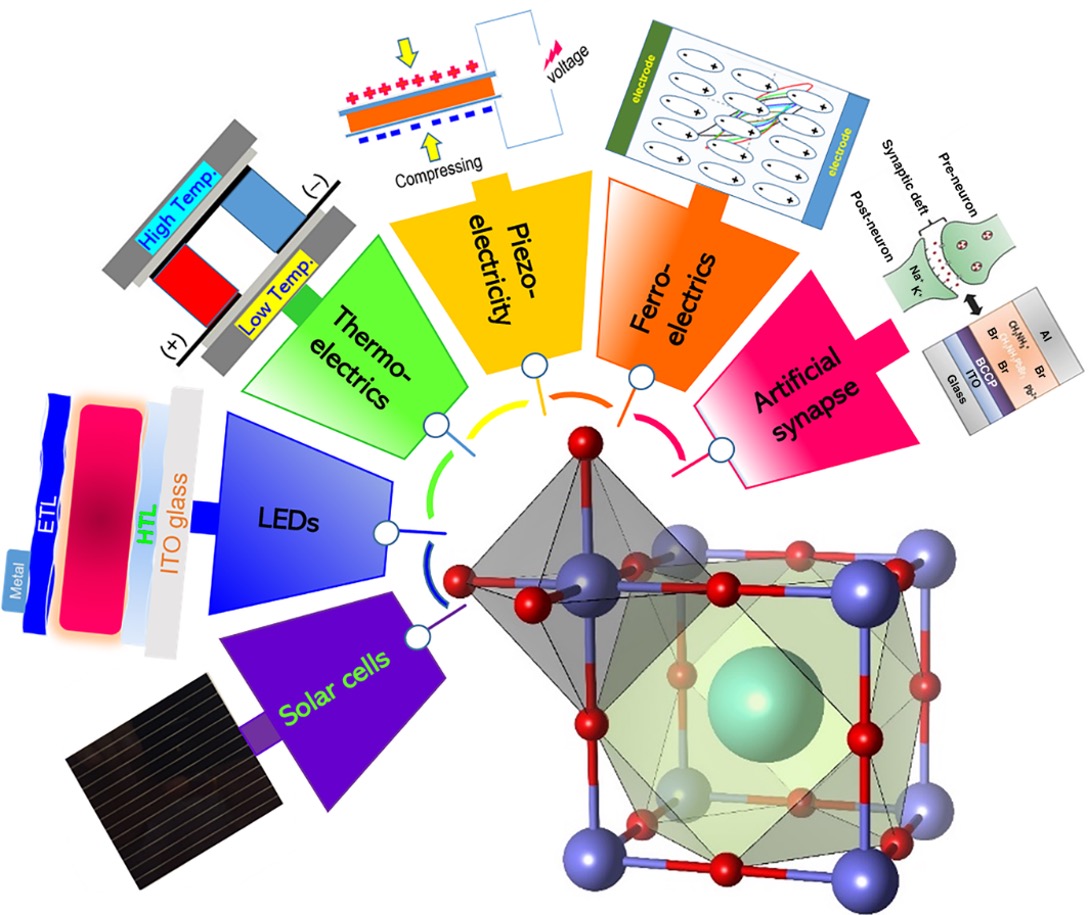

Perovskites for Optoelectronic Applications: A Sustainable Future?

Figure 1. Applications of halide perovskite materials and crystallographic structure [1].
As the world shifts towards sustainable and energy-efficient technologies, perovskite materials have become optoelectronics game-changers. From high-efficiency solar cells to next-generation LEDs and photodetectors, perovskites offer immense potential for revolutionizing modern electronics [2], [3]. However, toxicity and long-term stability concerns challenge their sustainability [4]. Lead-free alternatives, such as tin-based perovskites and double perovskites Cs2MScCl6 (M = Na, K), could be the key to a greener future [3], [5].
Perovskite materials are gaining traction due to their exceptional properties over traditional semiconductor materials. As they offer high power conversion efficiency (PCE), low-cost scalable manufacturing, defect tolerance, and versatility [6]. Perovskite solar cells (PSCs) have surpassed 25% efficiency, competing with silicon-based counterparts [7]. Unlike traditional semiconductors, perovskites can be processed at low temperatures, reducing energy consumption [6]. Fabrication of perovskites is simple and cost-effective compared to alternative technologies. Perovskite thin films can be deposited using solution-based methods like spin coating or inkjet printing, eliminating the need for expensive vacuum deposition techniques [6]. Perovskite materials exhibit a degree of defect tolerance that allows them to maintain performance even in structural imperfections [8]. This is vital for enhancing longevity and stability in devices. Perovskites also enable lightweight, flexible, and transparent optoelectronic devices suitable for solar panels, LEDs, and wearable electronics [9].
The most efficient perovskites contain lead (Pb), which is toxic and poses environmental and health risks. This has prompted researchers to explore tin (Sn) and Lead-free perovskites like Cs2MScCl6 (M = Na, K) as a sustainable alternative [3], [5]. Tin perovskites are lead-free, addressing toxicity concerns and the potential for safer solar cells and photonic devices [3]. They have comparable electronic properties to lead, enabling charge transport [5]. However, Tin perovskites are highly unstable due to tin oxidation (Sn²⁺ →Sn⁴⁺), leading to rapid degradation [3]. They have lower efficiency than lead-based perovskites and require innovative encapsulation and stabilizing additives to enhance durability [4].
Researchers are exploring future research directions to develop hybrid tin-lead perovskites that balance efficiency and toxicity while improving stability [3]. Other approaches include advanced encapsulation techniques, alternative metal halides, and recycling and safe disposal strategies. The urgency of addressing perovskite degradation is underscored by the current focus on advanced encapsulation techniques aimed at producing protective coatings to prevent degradation and strengthen stability, as perovskites are prone to degradation when exposed to moisture, oxygen, and heat [4], [9]. Bismuth- and antimony-based compounds are being explored as alternative metal halides[10]. Recycling and safe disposal strategies are also being explored to reduce e-waste and enhance environmental sustainability.
With the global shift towards greener technologies, perovskites hold tremendous potential for sustainable energy and optoelectronic advancements. However, the persistent issue of lead toxicity poses a significant challenge. While tin perovskite offers a promising alternative to addressing this challenge, improving its structural stability is key to its success. Therefore, continued research into non-toxic, high-performance perovskites will ensure a greener and more sustainable future for electronics.
Would you switch to tin-based perovskite devices if they became commercially available? Share your thoughts on sustainable materials in electronics!
Authors: Luckman Aborah Yeboah*, Wolalorm Makafui Zudor*, Samuel Osei-Amponsah
References
[1]S. Il Seok and T. F. Guo, “Halide perovskite materials and devices,” MRS Bull, vol. 45, no. 6, pp. 427–430, Jun. 2020, doi: 10.1557/MRS.2020.140.
[2]V. Pecunia, L. G. Occhipinti, S. G. Cloutier, S. Sun, A. N. Grace, and W. L. Leong, “Editorial: Focus on green nanomaterials for a sustainable internet of things,” Nanotechnology, vol. 35, no. 4, Jan. 2023, doi: 10.1088/1361-6528/AD0410.
[3]S. Sen, S. Gopalan, R. Sellappan, A. N. Grace, and P. Sonar, “Tin-Based Eco-Friendly Perovskites for Sustainable Future,” Advanced Energy and Sustainability Research, vol. 4, no. 12, p. 2300110, Dec. 2023, doi: 10.1002/AESR.202300110.
[4]H. Chen, X. Chang, G. Yang, B. X. Lei, and W. Q. Wu, “Cyclodextrin-assisted supramolecular host-guest inclusion for durable and sustainable optoelectronics,” Microstructures 2024;4:2024031., vol. 4, no. 3, p. N/A-N/A, May 2024, doi: 10.20517/MICROSTRUCTURES.2023.83.
[5]A. M. Afridi, N. A. Nipa, and M. Abdur Rashid, “First-principle investigation of lead-free double perovskites Cs2MScCl6 (M = Na, K) for optoelectronic and thermoelectric applications,” Phys Scr, vol. 99, no. 5, p. 055938, Apr. 2024, doi: 10.1088/1402-4896/AD38E9.
[6]M. Cadelano et al., “Photoexcitations and Emission Processes in Organometal Trihalide Perovskites,” Perovskite Materials - Synthesis, Characterisation, Properties, and Applications, Feb. 2016, doi: 10.5772/61282.
[7]J. Y. Kim, J. W. Lee, H. S. Jung, H. Shin, and N. G. Park, “High-Efficiency Perovskite Solar Cells,” Chem Rev, vol. 120, no. 15, pp. 7867–7918, Aug. 2020, doi: 10.1021/ACS.CHEMREV.0C00107.
[8]Y. Zhou et al., “Enhancing charge-emitting shallow traps in metal halide perovskites by >100 times by surface strain,” Joule, Jan. 2024, doi: 10.1016/j.joule.2024.10.004.
[9]L. Yang et al., “Record-Efficiency Flexible Perovskite Solar Cells Enabled by Multifunctional Organic Ions Interface Passivation,” Adv Mater, vol. 34, no. 24, Jun. 2022, doi: 10.1002/ADMA.202201681.
[10]J. He et al., “Prospect for Bismuth/Antimony Chalcohalides-Based Solar Cells,” Adv Funct Mater, vol. 33, no. 48, p. 2306075, Nov. 2023, doi: 10.1002/ADFM.202306075.
Comments
No comments available.